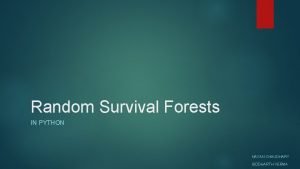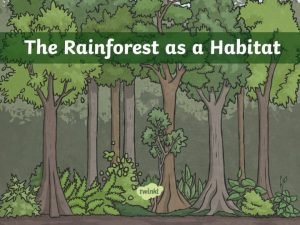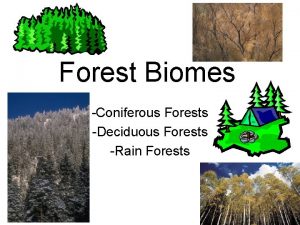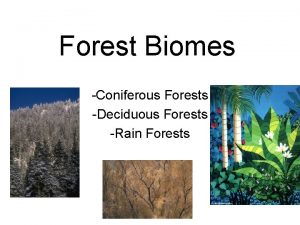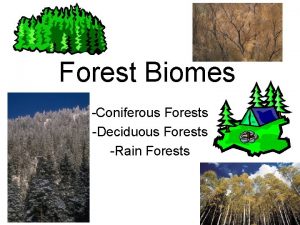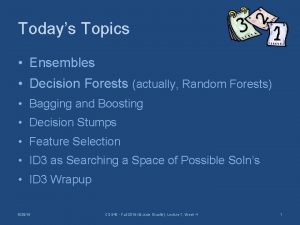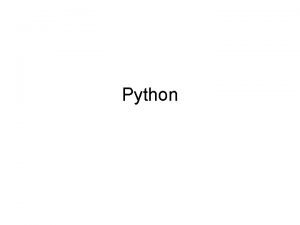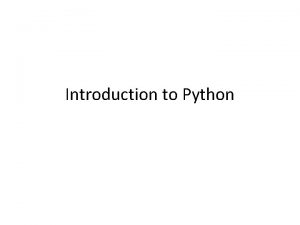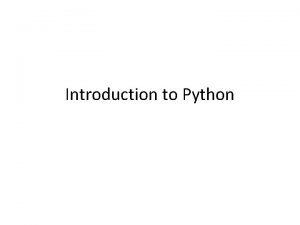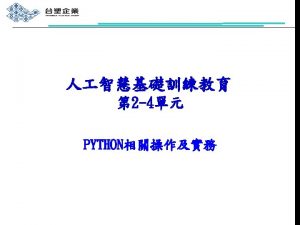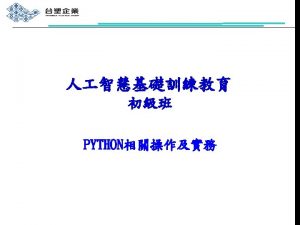Random Survival Forests IN PYTHON NAYAN CHAUDHARY SIDDHARTH





























- Slides: 29

Random Survival Forests IN PYTHON NAYAN CHAUDHARY SIDDHARTH VERMA

Contents Decision Trees and Random Forests Survival Analysis –Problem Statement Survival Random Forests Project Goals

Tree-based algorithms FOR CLASSIFICATION

What are Decision Trees? A decision tree is a flowchart-like structure in which Each internal node represents a "test" on an attribute (e. g. whether a coin flip comes up heads or tails) Each branch represents the outcome of the test Each leaf node represents a class label (decision taken after computing all attributes). The paths from root to leaf represent classification rules.

A Quick Example Source: http: //www. doc. ic. ac. uk

The Decision Tree Algorithm Source: A Course in Machine Learning by Hal Daume

Types of Decision Trees ID 3 (Iterative Dichotomiser 3) C 4. 5 (successor of ID 3) CART (Classification And Regression Tree) CHAID (CHi-squared Automatic Interaction Detector). Performs multi-level splits when computing classification trees. MARS extends decision trees to handle numerical data better.

Splitting Criterion The score function can differ based on the various criterions such as, Entropy and Information Gain Used in ID 3, C 4. 5, C 5. 0 Trees Inspired from Information Theory H(T) represents the Entropy of the parent node. H(T|a) is the weighted sum of the entropies of the child node. Used in CART GINI Impurity Index Measure of how often a randomly chosen element from the set would be incorrectly labeled if it was randomly labeled according to the distribution of labels in the subset.

Decision Tree Boundary Feature 2 Piece-wise Linear Feature 1 Source: Machine Learning w/ Spark

Decision Trees are great… Are simple to understand interpret. People are able to understand decision tree models after a brief explanation. Have value even with little hard data. Allow the addition of new possible scenarios. Help determine worst, best and expected values for different scenarios. Can be combined with other decision techniques.

… except when they aren’t! Most splitting criterion follow a greedy approach as they make the optimum decision at each node without taking into account the global optimum. Decision trees are prone to overfitting, especially when a tree is particularly deep. How can we minimize the effects of bias and variance from Decision Trees?

Enter Random Forest Random forest builds multiple decision trees and merges them together to get a more accurate and stable prediction. Instead of searching for the best feature while splitting a node, it searches for the best feature among a random subset of features. This is known as an “ensemble approach” and creates a wide diversity, which generally results in a better model.

A Quick Example Source: Towards Data Science

The Random Forest Algorithm 1. At the current node, randomly select p features from available features D. The number of features p is usually much smaller than the total number of features D. 2. Compute the best split point for tree k using the specified splitting metric (Gini Impurity, Information Gain, etc. ) and split the current node into daughter nodes and reduce the number of features D from this node on. 3. Repeat steps 1 to 2 until either a maximum tree depth l has been reached or the splitting metric reaches some extrema. 4. Repeat steps 1 to 3 for each tree k in the forest. 5. Vote (class mode) or aggregate (averaging etc) on the output of each tree in the forest. Source: Towards Data Science

Time Complexities Building Decision Trees (unpruned) Building Random Forests Parameters needed Number of observations, n Number of attributes, v Number of trees, nt Number of attributes (per tree) vt TC = O(v * n log n) TC = O(nt * vt * n log n)

Survival Analysis

Survival Analysis Think of following scenarios: How long will a patient ‘survive’ given pre-existing medical conditions and certain treatment ? How long before a customer ‘makes’ a purchase given their demographics and surfing history ? How long before a device ‘fails’ given the device characteristics ? How long before a student ’drops out’ given their family history, grades, locality etc. ?

Survival Data Analysis Window Censored Event Subjects Other event Time

Survival Analysis

Survival Analysis

Survival Analysis Methods Statistical Methods Non-Parametric Kaplan Meier Semi-parametric Cox Regression parametric Accelerated Failure Time Survival Trees Survival SVM Machine Learning Methods Survival Ensembles ……

Survival Analysis Methods Statistical Methods Non-Parametric Kaplan Meier Semi-parametric Cox Regression parametric Accelerated Failure Time Survival Trees Survival SVM Machine Learning Methods Survival Ensembles ……

Kaplan Meier 2 3+ 6 6 7+ 10 15+ 15 16 27 30 32

Survival Forest - Algorithm Draw B bootstrap samples from the original data. Note that each bootstrap sample excludes on average 37% of the data, called out-of-bag data (OOB data). Grow a survival tree for each bootstrap sample. At each node of the tree, randomly select p candidate variables. The node is split using the candidate variable that maximizes survival difference between daughter nodes. Grow the tree to full size under the constraint that a terminal node should have no less than d 0 > 0 unique deaths. Calculate a CHF for each tree. Average to obtain the ensemble CHF. Using OOB data, calculate prediction error for the ensemble CHF.

Survival Difference ? Log Rank Test

Evaluation Metric(s) Can’t use R 2 as the problem not of standard regression. Can’t use standard classification measures as well. Use specialized evaluation metrics for survival analysis: C-index Brier Score Mean absolute error

Evaluation metric: C-index Without Censoring With Censoring A total of 5 C 2 comparable pairs Comparable only with events a with those censored after the events

Project Goals Replicate R package for Survival Random Forests in Python Write good documentation which increases ease-of-use Something like - http: //lifelines. readthedocs. io/en/latest/index. html But with Survival Forests implementation

References Wikipedia Pages on Decision Tree and Random Forests The Random Forest Algorithm – Towards Data Science by Niklas Douges A Course in Machine Learning by Hal. Daume Machine Learning with Spark Random Survival Forests – Ishwaran et. al , 2008 Machine Learning for survival analysis, Reddy et. al
 Survival tree python
Survival tree python State of survival survival of the fittest tweak
State of survival survival of the fittest tweak State of survival survival of the fittest stages
State of survival survival of the fittest stages Samvant
Samvant Nayan thakkar
Nayan thakkar Kamal ke saman nayan
Kamal ke saman nayan Dr nayan thakkar
Dr nayan thakkar Nayan hajratwala
Nayan hajratwala Siddharth rupavatharam
Siddharth rupavatharam Siddharth karkare
Siddharth karkare Siddharth coelho-prabhu
Siddharth coelho-prabhu Siddharth rupavatharam
Siddharth rupavatharam Aifis
Aifis Siddharth malhotra, md
Siddharth malhotra, md Swoh
Swoh Aman chaudhary
Aman chaudhary Jumman sheikh and algu chaudhary story in english
Jumman sheikh and algu chaudhary story in english Chaudhary
Chaudhary Bepin choudhury lapse of memory lesson plan
Bepin choudhury lapse of memory lesson plan Muawiz chaudhary
Muawiz chaudhary Swapna chaudhary
Swapna chaudhary Manish chaudhary mathura
Manish chaudhary mathura Random assignment vs random selection
Random assignment vs random selection Random assignment vs random sampling
Random assignment vs random sampling Deciduous forests around the world
Deciduous forests around the world Forests reach their greatest ecological complexity when
Forests reach their greatest ecological complexity when Very dense warm and wet forest
Very dense warm and wet forest Healthy forests healthy communities poster contest
Healthy forests healthy communities poster contest Forests
Forests 12 forests of vrindavan
12 forests of vrindavan
